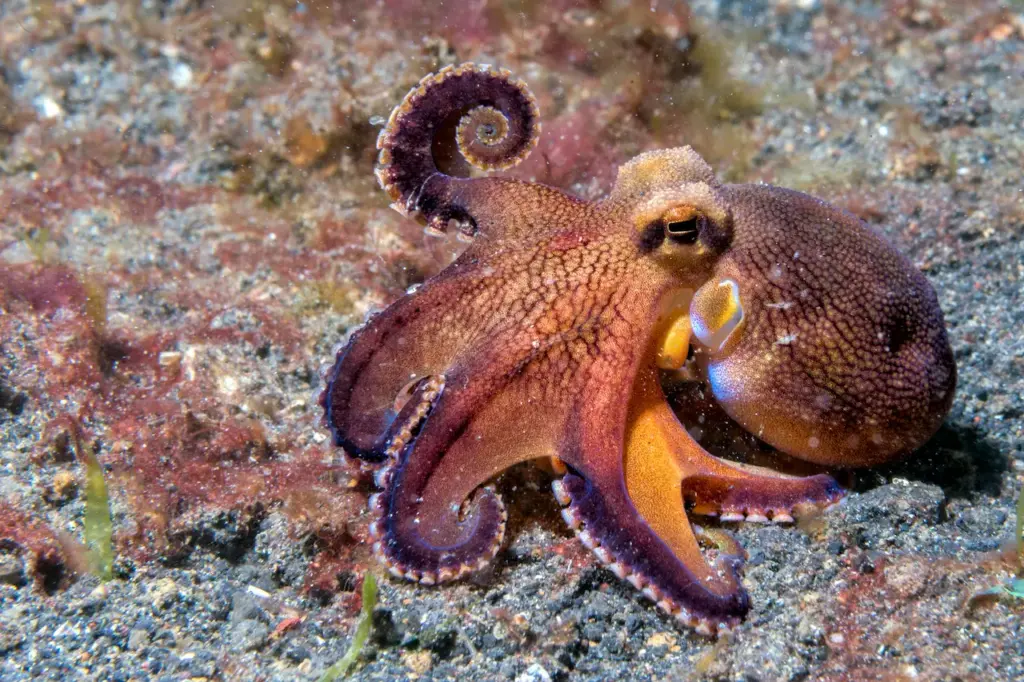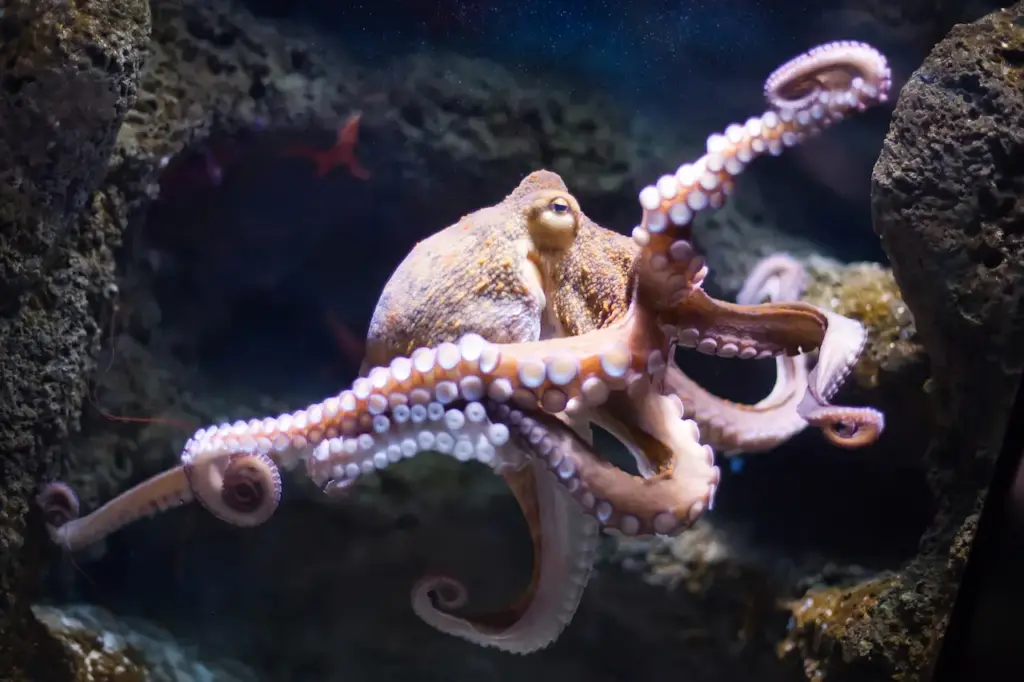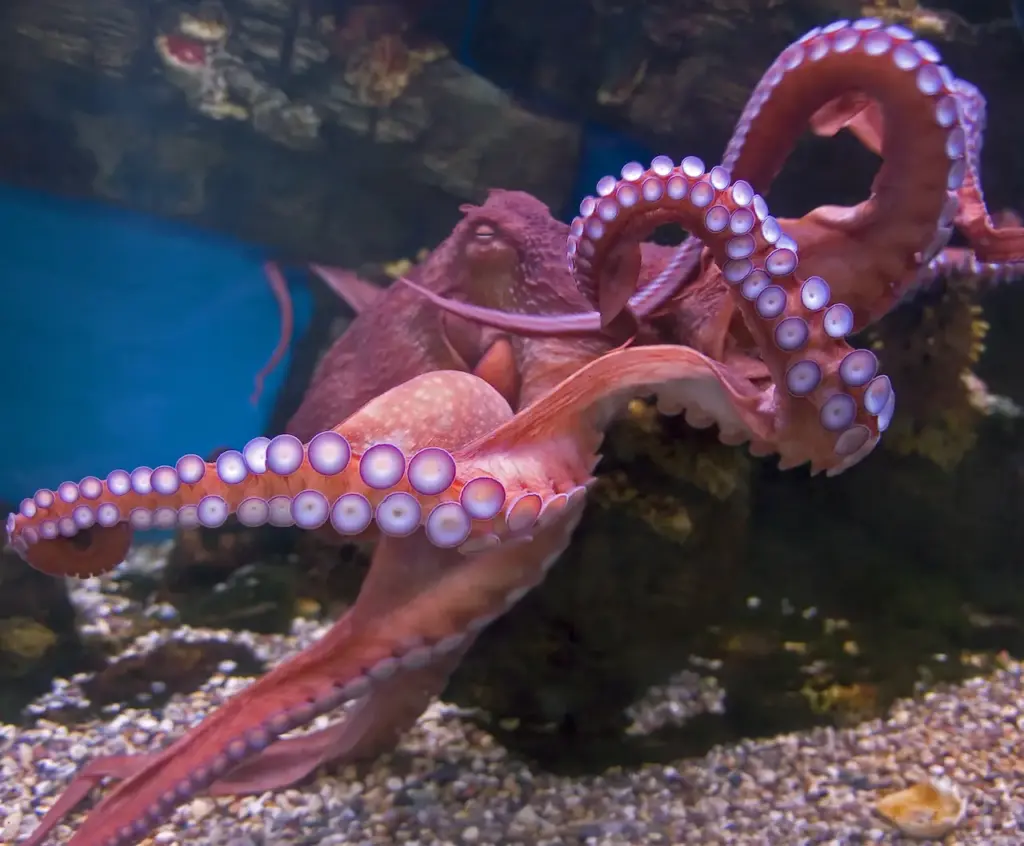Octopus
Categories
- Accipitridae (1)
- Acrididae (1)
- Algae (2)
- Alligatoridae (1)
- Amoebidae (1)
- Amphibians (3)
- Anatidae (1)
- Anguillidae (1)
- Arachnids (2)
- Bears (2)
- Big Cats (3)
- Birds (13)
- Bovidae (5)
- Bufonidae (1)
- Camelids (1)
- Cameras (1)
- Canines (13)
- Caridea (1)
- Carnivora (10)
- Castoridae (1)
- Cats (5)
- Cebidae (1)
- Cephalopod (1)
- Cervidae (2)
- Cetacean (1)
- Chondrichthyes (1)
- Crocodilia (2)
- Crustaceans (4)
- Culicidae (1)
- Cyaneidae (1)
- Dasypodidae (1)
- Dasyurids (1)
- Deer (1)
- Delphinidae (1)
- Desktop (1)
- Didelphidae (1)
- Dinosaurs (1)
- Dogs (13)
- Dolphins (2)
- Echinoderms (1)
- Education (10)
- Elephantidae (1)
- Equine (1)
- Erethizontidae (1)
- Erinaceidae (1)
- Farming (1)
- Felidae (5)
- Fish (5)
- Food Chain (31)
- Food Web (2)
- Formicidae (1)
- Frugivore (1)
- Gaming (1)
- Gastropods (1)
- Giraffids (1)
- Great Apes (2)
- Health Conditions (3)
- Herbivore (4)
- Hi-Fi (1)
- Hippopotamidae (1)
- Hominidae (1)
- Insects (10)
- Invertebrates (2)
- Keyboards (1)
- Laptops (1)
- Leporidae (1)
- Mammals (23)
- Marsupials (4)
- Mephitidae (1)
- Microchiroptera (1)
- Mollusks (2)
- Mongoose (1)
- Muridae (1)
- Nocturnal Animals (1)
- Odobenidae (1)
- Omnivore (2)
- Phasianidae (1)
- Phocidae (1)
- Plankton (1)
- Plants (2)
- Primate (1)
- Ranidae (1)
- Reptiles (7)
- Rhinocerotidae (1)
- Rodents (5)
- Salamandridae (1)
- Scarabaeidae (1)
- Sciuridae (2)
- Sharks (1)
- Shellfish (1)
- Sound (1)
- Spheniscidae (1)
- Suidae (1)
- Superfamily Papilionoidea (1)
- Theraphosidae (1)
- What Eats (5)
Scientists and the public alike have long been intrigued by octopuses due to their amazing intelligence and complex behaviour that rivals that of higher vertebrates. Extensive research has shown that octopuses possess cognitive ability that rivals that of vertebrate animals – evidenced by problem-solving skills, memory capabilities, learning characteristics and even forms of play behaviour.
Studies have revealed that octopuses possess remarkable cognitive flexibility, with studies revealing they are adept at navigating mazes, manipulating objects with precise arm movement, demonstrating planning and decision-making behaviours, and using tools for defence or shelter such as shells to demonstrate this flexibility further.
Table of Contents
Toggle
Octopus
What Does Octopus Eat?
This research presents an in-depth exploration of octopus life, from their body structures and cognitive capabilities, to how evolutionary forces may have shaped their intelligence. Furthermore, this investigation seeks to examine various aspects of its behaviour and physiology to better comprehend why octopods are often considered marine geniuses.
Octopuses are notoriously fast feeders with an adaptable diet varying depending on species, size and habitat. Here are some commonly consumed prey items for an octopus:
Crustaceans:
Octopuses feed on various crustacean species like crabs, shrimp, lobsters, and crayfish by using their powerful and agile arms covered with hundreds of suckers to capture and secure prey items such as crab shells or extracting meat from shrimp bodies. With such strong yet precise arms at their disposal, octopuses are capable of hunting down and devouring an impressive range of crustacean species from their ocean habitats efficiently.
Mollusks:
Bivalves like clams and mussels, as well as gastropods such as snails and whelks, make up a significant part of an octopus’s diet. Octopuses use their powerful beak to pry open tightly sealed bivalves with precision or drill through them with force so as to access their soft, nutritious flesh contained within protective casings – this allows octopuses to take advantage of various shellfish species within marine ecosystems through effective manipulation.
Fish:
Octopuses are highly skilled predators that prey upon small fish for food. To do so, they employ both ambush tactics and agile hunting maneuvers in order to catch their prey, such as lying in ambush in camouflaged surroundings ready to strike if one comes too close; or actively pursuing them through water bodies using stealth tactics in order to outwit their prey – both techniques being vital means by which these aquatic predators efficiently secure nutrients vital to their underwater environments.
Worms and Annelids:
Certain species of octopus will also prey upon polychaete worms and other types of marine-floor living annelids for food.
Amphipods and Isopods:
These small shrimp-like crustaceans form part of the diet of many species of octopus that forage along the seabed.
Echinoderms:
Octopuses can eat sea stars (starfish), sea urchins and other forms of echinoderms that have hard exoskeletons to access the soft tissues inside. They have the capability of prying open these exoskeletons by grasping onto them with their arms before prying open their exoskeletons to reach what lies within.
Cannibalism among Octopuses:
When food sources become scarce or there are territorial disputes, cannibalism among octopuses may increase significantly.
Octopuses are well known for their intelligence and adaptability in finding and capturing prey. They utilize stealth, camouflage, dexterous arms, stealth behaviour and stealth behaviour to hunt efficiently in their underwater environment. Furthermore, their varied diet demonstrates their capacity to access various marine ecosystems for food sources.

Octopus Underwater
What Eats Octopus?
Octopuses may be adept predators in the ocean, but they do have natural enemies they must contend with as predators. Different marine species have been documented preying upon octopuses based on size and habitat considerations; here are some of the major predators of octopuses:
Sharks:
When encountered during their hunting grounds, larger species of sharks such as tiger sharks and great white sharks often prey upon octopuses as food sources.
Predatory Fishes:
Groupers and lingcod are capable of hunting and devouring juvenile or smaller octopuses when they become vulnerable.
Seabirds:
Seagulls and cormorants have long been known to collect octopuses that come to the surface or are exposed in tide pools for consumption by seabirds such as themselves.
Eels and Moray Eels:
While octopuses themselves are formidable predators, larger species of eels and moray eels may also prey upon smaller octopuses.
Dolphins and Seals:
As marine mammals, dolphins and seals may consume octopuses as an opportunity arises during their foraging activities.
Cannibalism among Octopuses:
Cannibalism can occur among octopuses who share an aquatic environment where resources are limited and compete for survival.
Octopuses have developed various defence mechanisms to evade predation, such as camouflage, ink release and rapid movement to escape potential predators. Their ability to fit through tight spaces and agility in water are also invaluable assets when evading capture by larger predators.
Sensory Organs
Octopuses possess highly developed sensory systems, including camera-like eyes that possess excellent vision. Furthermore, their skin has olfactory receptors capable of sensing chemicals present in water; this makes them excellent escape artists and hunters with chemical recognition skills.
Cognitive Abilities of Octopus
Octopuses have long been revered for their intelligence. This shows up in many forms: intricate hunting tactics, problem-solving abilities, tool use and social behaviour. Their mental capacities have been extensively examined over the years; studies reveal a level of complexity comparable to some vertebrate species.
Octopuses demonstrate incredible tool use and problem-solving ability. For instance, they were observed opening jars or boxes under controlled conditions to catch prey – an act requiring manual dexterity as well as cognitive planning. Furthermore, some species employ coconut shells or stones as barriers against their surroundings or create protective barriers around their home.
Researchers have demonstrated that octopuses possess both short- and long-term memories, enabling them to learn from past experiences and adjust to new environments. Both associative and observational learning techniques are employed, the latter by linking stimuli together or watching others; both processes rely on complex nervous systems with regulatory RNAs for gene activity control to accomplish this feat.
Though typically considered non-social animals, octopuses do exhibit some social behaviours. They have the ability to recognize individual humans and form preferences for certain individuals. Some species even display parental care by caring for their eggs until hatching takes place – these behaviours indicate social awareness and individual identification that is often not found among other invertebrates.

Closeup Image of Octopus
Behavioural Flexibility of an Octopus
Octopus intelligence can be defined by their behavioural flexibility. They adapt their behaviour according to the situation at hand and use simple means to reach complex results. Octopuses exhibit this trait by adapting their behaviour quickly according to environmental challenges – using tools or camouflaging themselves effectively when responding.
Octopuses: Anatomy and Physiology
The class Cephalopoda comprises cuttlefish and squid, all soft-bodied molluscs with decentralized nervous systems which make them stand out among other animals. Octopuses’ neurons are distributed throughout their arms instead of being congregated primarily within their brain allowing greater independence in terms of movement and behaviour.
Nervous System A common octopus (Octopus var.), has roughly the same number of neurons found in most dogs. However, unlike dogs, most of their neurons do not reside in their brain but in its arms instead – each arm is equipped with its own “mini-brain”, enabling it to perform complex tasks without assistance from its central nervous system – thus showing impressive dexterity and even solving complex problems without help from anyone else.
Cephalopods boast unique circulatory systems due to copper-based hemocyanin protein that effectively transports oxygen at lower temperatures with reduced oxygen usage. Two hearts pump blood directly through their gills while another circulates it throughout their bodies – all contributing to an active lifestyle and high metabolism.
